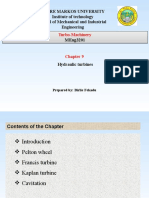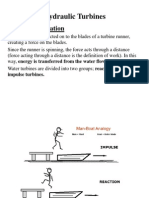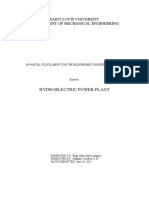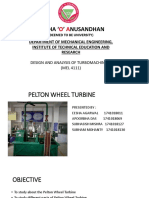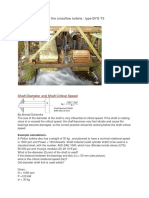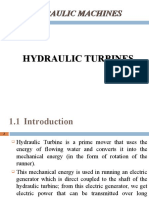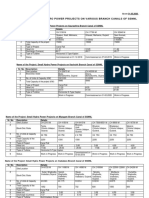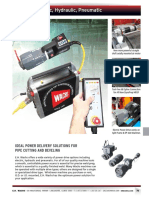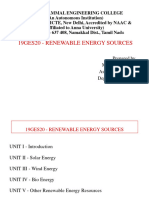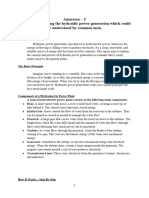An Approach To Modify Pelton Wheel Using Potential Energy at Low Head
An Approach To Modify Pelton Wheel Using Potential Energy at Low Head
Uploaded by
hemal4379Copyright:
Available Formats
An Approach To Modify Pelton Wheel Using Potential Energy at Low Head
An Approach To Modify Pelton Wheel Using Potential Energy at Low Head
Uploaded by
hemal4379Original Description:
Original Title
Copyright
Available Formats
Share this document
Did you find this document useful?
Is this content inappropriate?
Copyright:
Available Formats
An Approach To Modify Pelton Wheel Using Potential Energy at Low Head
An Approach To Modify Pelton Wheel Using Potential Energy at Low Head
Uploaded by
hemal4379Copyright:
Available Formats
See discussions, stats, and author profiles for this publication at: https://www.researchgate.
net/publication/289537129
AN APPROACH TO MODIFY PELTON WHEEL USING POTENTIAL ENERGY AT
LOW HEAD
Conference Paper · November 2015
CITATIONS READS
0 475
3 authors, including:
Md. Mehdi Masud Talukder
Chittagong University of Engineering & Technology
7 PUBLICATIONS 3 CITATIONS
SEE PROFILE
Some of the authors of this publication are also working on these related projects:
Fish culture in floating net cages View project
All content following this page was uploaded by Md. Mehdi Masud Talukder on 08 January 2016.
The user has requested enhancement of the downloaded file.
Proceedings of the
International Conference on Mechanical Engineeringand Renewable Energy 2015
(ICMERE2015) 26 – 29 November, 2015, Chittagong, Bangladesh
ICMERE2015-PI-283
AN APPROACH TO MODIFY PELTON WHEEL USING POTENTIAL ENERGY AT
LOW HEAD
I. C. Das1, M. M. M. Talukder2,* and M. A. Islam3
1
Technical Designer, Scan Machinery (BD) Ltd., Chittagong, Bangladesh.
2,3
Department of Mechanical Engineering, Chittagong University of Engineering & Technology, Chittagong-4349,
Bangladesh.
1
indramecuet041@yahoo.com, 2,*mehdi.cuet@gmail.com, 3aislam@cuet.ac.bd
Abstract- A Pelton-wheel impulse turbine is an energy conversion device that converts gravitational energy
of elevated water into mechanical work, which can be converted into electrical energy using an electrical
generator. The kinetic energy produced by the water-jet is directed tangentially to the buckets of the
Pelton-wheel; generally major amount of the jet energy is used in propelling the rim of the buckets and
some passes to the tail race without doing any useful work. Conventional Pelton wheel is mostly used for
high-water head applications consuming only kinetic energy from the source, which consists both kinetic
and potential energy; whereas, the modified Pelton wheel can operate at low-head and can be used in
heavy-discharge applications using considerable amount of potential energy with the kinetic energy.
Consequently, this modified Pelton wheel will open new horizon for Mini and Micro hydro power plants
available in Bangladesh.
Keywords: Gravitation, Jet-propulsion, Pelton-wheel efficiency, Potential-head, Water-jet,Hydropower
1. INTRODUCTION of motion) spins the turbine and removes kinetic energy
The energy of falling water as a source of energy is from the fluid flow. Before reaching the turbine, the
known for a long time. This is called Hydro energy. The fluid's pressure head is changed to velocity head by
amount of stored hydro energy is directly proportional to accelerating the fluid through a nozzle. This preparation
the height and amount of the water above sea level. This of the fluid jet means that no pressure casement is needed
energy is capitalized by the use of the devices, called around an impulse turbine. The conduit bringing
water turbines. A turbine is a rotary engine that extracts high-pressure water to the impulse wheel is called the
energy from a fluid flow and converts it into useful work. penstock. This was strictly just the name of the valve, but
The simplest turbines have one moving part, a rotor the term has been extended to the conduit and its
assembly, which is a shaft or drum with blades attached. appurtenances as well, and is a general term for a water
Moving fluid acts on the blades, or the blades react to the
passage and control that is under pressure, whether it
flow, so that they move and impart rotational energy to
the rotor. Turbines are of basically two types, such as, serves an impulse turbine or not.
impulse and reaction turbine. The goal of this work is to A practical impulse turbine was invented in California
use the impulse type water turbine say, Pelton wheel to around 1870. Afterwards, the buckets were modified to
generate electricity and to modify it on the gravitational split buckets in 1880 which are now universally used to
basis. The Pelton wheel is a tangential flow free jet produce power [7].
impulse turbine. A nozzle transforms water under a high
head into a powerful jet. The momentum of this jet is 2.1 Conventional Pelton Wheel
destroyed by striking the runner, which absorbs the A Pelton wheel is an impulse turbine that has at least one
resulting force. If the velocity of the water leaving the free jet. The jets release water into an aerated space
runner is nearly zero, all of the kinetic energy of the jet where it is caught by a series of buckets or cups located
has been transformed into mechanical energy, so the on the runner, the rotating piece of the turbine that is used
efficiency is high. This type of free-jet water turbine is to convert the water's energy into mechanical energy.
first introduced by an American; named LesterPelton and Typically, these buckets are divided into two sections so
the device is called the Pelton Wheel or Pelton turbine they are able to deflect water away from the oncoming
[7]. jets. A Pelton wheel also has a cutaway on the lower lips
of the buckets, which allows a subsequent bucket to
2. IMPULSE OR VELOCITY TURBINES move ahead before it stops the water jet that has moved
It is one of the major types of turbines, along with the previous bucket. As a result, the buckets enter the
reaction turbines. Impulse turbines operate based on the water jet more smoothly.
concept of velocity, namely by changing the direction of
a jet of either fluid or gas. This impulse in turn rotates the 3. WORKING PRINCIPLE OF PELTON TURBINE
turbine and creates energy. A turbine that is driven by The water from the reservoir flows through a penstock
high velocity jets of water or steam from a nozzle which contains a nozzle at the outlet. The nozzle
directed on to vanes or buckets attached to a wheel. The increases the kinetic energy of the penstock water. At the
resulting impulse (as described by Newton's second law
© ICMERE2015
outlet this nozzle produces a water-jet. This water-jet sum of the pressure head and the approach velocity head.
strikes on buckets of the runner and transfers its kinetic The theoretical jet velocity is V = √ (2gh). Let's analyze
energy to the bucket’s wheel. The general formula of any an ideal wheel, and assume that this is actually the jet
hydraulic system is: velocity. The peripheral velocity of the runner is u.
𝑃 = ƞ𝜌𝑄𝑔𝐻(1)
Where,
P is the mechanical power produced at the turbine shaft
in watts.
Ƞ is the hydraulic efficiency of the turbine.
ρ is the density of the water in kg/m3 .
g is the acceleration due to gravity in m/s2 .
Q is the volume flow rate passing through the turbine Fig.3: Vector diagram of velocity transformation [2]
inm3/s.
H is the effective pressure head of water across the The vector diagram above shows how the velocity is
turbine in meter. transformed by the runner. For simplicity, we assume that
For an impulse turbine of pelton wheel type, the all velocities are in the same straight line. The relative
mechanical power can be changed by means of changing velocity of approach to the runner is V - u. We assume
Ƞ, Q and H inputs as g and ρ are constants. that this velocity is reversed, so that the final velocity is
A Pelton turbine consists of a set of specially shaped V - 2u.
buckets mounted on a periphery of a circular disc. It is The force F on the runner is the rate of momentum
turned by jets of water which are discharged from one or change, or
more nozzles and strike the buckets. The buckets are split F = ρ[V + (V - 2u)]Q
into two halves so that the central area does not act as a = 2ρ(V - u)Q(2)
dead spot incapable of deflecting water away from the
oncoming jet. Where, ρ is the density and Q the volume rate of flow of
water.
The torque on the runner,
T = FD/2 = ρD(V - u)Q (3)
4. MODIFICATION OF THE PELTON WHEEL
DESIGN
Pelton wheel is generally used for high head and low
discharge applications. But it can be used for the low
Fig.1: Impingement of jet and flow at outlet [1] head also by adding some modifications in design.
Splitters are used to increase the efficiency of the outlet
The cutaway on the lower lip allows the following bucket of the water jet so that water can leave the bucket with a
to move further before cutting off the jet propelling the minimum velocity which is theoretically assumed tends
bucket ahead of it and also permits a smoother entrance to zero. The special modification is to increase the depth
of the bucket into the jet. of the buckets which is not done in the usual pelton wheel
The Pelton bucket is designed to deflect the jet through buckets. In case of conventional Pelton wheel, only
165 degrees (not 180 degrees) which is the maximum kinetic energy of the jet impinged from the nozzle, is
angle possible without the return jet interfering with the used but there is no application of gravity in the turbine
following bucket for the oncoming jet [4]. action. In this gravitational low head Pelton wheel, both
the kinetic and gravitational energy of the jet are used.
The weight of this stored water per second in the bucket
is the amount of potential energy per second from water
jet.
Furthermore, this potential energy is converted into
kinetic energy as this water filled bucket freely
(assumed) falls. It is also possible to extract kinetic
energy from the penstock nozzle discharge by means of a
Fig. 2: Energy conversion in impulse turbine [2] jet strike on the conventional Pelton-wheel vanes of the
runner. This hydro system is good for a low-head and
A diagram of a Pelton wheel is shown on the figure. The heavy-discharge application. Apart from this,
wheel of pitch diameter Dhas buckets around its gravitational energy of stored water is further extracted
periphery, so spaced that the jet always strikes more than during emptying of bucket water by means of
one at a time. The buckets have the form shown at the jet-propulsion under water head. This jet propulsion
upper left, where the water enters at a splitter and is works on a runner wheel taking place due to the
diverted to each side, where the velocity is smoothly Gravitational-Force on bucket’s stored water and results
reversed. Bucket sizes are from 2.5 to 4 times the jet in a water jet discharge. Stored water of bucket enables
diameter. The total head supplying the nozzle is h, the
© ICMERE2015
delivery of two kinds of gravitational work on the runner Jet diameter, d = 1.2 cm
wheel. They are in the form of kinetic energy conversion Buckets, Z =12
during its under-gravity free falling and in the form of Bucket length, A = 4cm,
jet-propulsion during its discharge from bucket-cup Width, B=3cm,
under gravitational pulling. In addition, as like Depth, C=2.5cm
Pelton-wheel, there is a provision for jet impulse on Specific speed, Ns = 119.65 RPM.
buckets.
4.2 Experimental Setup
4.1 Design of Pelton Wheel A modified Pelton wheel is made which is consisting of
The designing of the Pelton wheel consists of some runner, bucket with splitters, shaft, gearing arrangement,
design inputs, assumptions and design parameters. a small generator or dynamo etc. Data is collected using
Design Inputs: measuring instruments such as stop watch, beaker,
Pressure head, H = 1.5 m tachometer, multimeter etc. A water tap (flow control
Power developed, P = 1W valve) from laboratory is used as a nozzle to conduct the
Assumptions: experiment.
Co-efficient of velocity of the nozzle, Cv=0.98
Overall efficiency, ηturbine = 85%
Ratio of peripheral velocity to jet velocity,
U/Cactual = 0.48
Designed Parameters:
Diameter of the wheel = D
Diameter of the jet = d
Size of bucket i.e. Length = A
Width = B
Depth = C
Number of buckets = Z
Calculations: Fig.4: Manufactured pelton wheel (Front & Side view)
Actual velocity of the jet, Cactual = Cv√ (2gh)
=4.34 m/s 5. RESULTS AND DISCUSSION
Speed of the runner, U = Cactual×0.48 In the analysis of experimental data, it was found that
=2.08m/ Cv maximum power produced 0.347 watt when maximum
=0.43 to 0.48 voltage is 2.01V for the maximum discharge of 106
Flow rate, Q = P/ρgHηturbine mL/s.
= 0.388L/s
Diameter of jet, d=√ (4Q/πCactual)
= 1.2cm
Diameter of the wheel, D =16×1.2
=19.2 or, 20cm here. D/d=16
Number of buckets, Z = 11+D/2d
=11.83 or, 12
Size of Bucket: length, A = 2.8d to 3.5d
Or, A = 4cm
Width, B = 2.3d to 2.8d
Or, B = 3cm
Depth, C = 2.5cm
Wheel velocity, 𝑈 = 𝜋𝐷𝑁 ⁄60 Fig. 5: Voltage, Output Power, Current Vs. Discharge
Or, N= 198.625 rpm graph
= 3.31 rps
The Specific Speed of a turbine is the speed in RPM at
which a similar model of the turbine would run under a
head of 1m. When of such a size as to develop 1 W. Note
the suffix "s" is used to denote the values associated with
the Specific Turbine.
For specific speed of turbine, Ns= (N√P)/(H^(5/4))
=119.625 rpm
Specific speed is higher for the low head and high
discharge. On the other hand it is lower for the high head
and low discharge. It is a very important criterion for
selecting a turbine for the same geometrical and Fig. 6: Efficiency Vs. Discharge graph
dynamically similar turbines.
RPM of runner, N = (U×60)/(π×D)=3.3 rps Different types of graphs among discharge, voltage,
So, wheel diameter, D = 20 cm power and efficiency are plotted using the data from this
© ICMERE2015
experiment. From the graph of figure 5, we can see that maximum energy of water jet.
each parameter is increasing with the increment of
discharge. 8. ACKOWLEDGEMENT
From efficiencyvs. discharge graph of figure 6, we can This work was partially funded by the Chittagong
also notice that the efficiency of the turbine is increasing University of Engineering & Technology (CUET) as an
significantly along with the discharge. It is due to that the undergraduate project.
inertia of wheel becomes more negligible with the
increment of the discharge. When data was taken for this 9. REFERENCES
experiment, the discharge was not so heavy. So the [1] DavidHalliday, Robert Resnick and Jearl Walker
system loss was not recovered fully. It is noteworthy that (2004), Fundamental of Physics (Sixth Edition), John
the maximum efficiency was achieved is 21.65% for the Wiley & Sons, Inc., New York.
maximum discharge. [2] Hugh D. Young, and Roger A. Freedman (1998),
So, it can be said that to get high efficiency, the turbine is University Physics (Ninth Edition), Addison Wesley
needed to be operated in high discharge applications. Longman, Inc., New York, 1998.
Improved gearing arrangement & larger buckets could [3] Victor L. Streeter and E. Benjamin Wylie (1981),
give better efficiency as well. Fluid Mechanics, McGraw-Hill Book Company New
York.
6. FUTURE SCOPES AND RECOMMENDATIONS [4] Robert L. Daugherty, Joseph B. Franzini, E. John
Finnemore (1989), Fluid Mechanics with Engineering
It can be recommended to minimize the inertial losses to Applications, McGraw-Hill Book Company, New York.
increase the efficiency. Tachometer should be attached to [5] SurajYadav, “Some Aspects of Performance
read the rpm continuously. The shaft should be kept Improvement of Pelton Wheel Turbine with
straight as much as possible to keep the outputconstant. Reengineered Blade and Auxiliary Attachments”,
This type of turbine with large scale design can be used International Journal of Scientific & Engineering
in large discharging canals or water exhausting system of Research, Vol. 2, Issue 9, September-2011,
different industries for producing power to electrify the ISSN 2229-5518
isolated rural areas. For example, it is possible to use the [6] “Small & Micro Hydropower”, Volume 9, Issue 4,
cooling water exhaust of a thermal power plant to www.smallhydro.com, Accessed 28/10/2011
produce about 1kW of power that can be used for [7] “Lester Allan Pelton.” http://www.vermilionohio.org/.
electrification purposes. Accessed 20/10/2011.
Pelton turbines are not used at lower heads because their
rotational speeds become very slow and the runner 10. NOMENCLATURE
required is very large and bulky. If runner size and low
speed do not pose a problem for a particular installation, Symbol Meaning Unit
then a Pelton turbine can be used efficiently with fairly
P Mechanical (Watt)
low heads. powerproduced at the
If a higher running speed and smaller runner are required turbine shaft
then there are two further options are available such as Ƞ Hydraulic efficiencyof [-]
increasing the number of jets and using twin runners. the turbine
ρ Density of the water (Kg/m3)
7. CONCLUSION
A modified gravitational Pelton-wheel is more effective g Acceleration due to (m/s2)
for low-head and heavy discharge applications. For the gravity
same head condition, heavy electrical generators can be Q Volume flow ratepassing (m3/s)
used for the modified gravitational Pelton-wheel than the through the turbine
conventional Pelton-wheel. The energy content in the H Effective pressure head (m)
runner shaft is lower in the conventional Pelton wheel. of wateracross the
The modified wheel is more competent than the turbine
conventional impulse and reaction turbines. The Ns Specific speed of turbine (rpm)
development and fabrication of this turbine is not so
N Wheel velocity (rps)
tough in industrial aspects due to the available
fabrication techniques of welding in the industrial Cv Co-efficient of velocity [-]
workshops. However, it is not so easy to fabricate
manually rather than industrial aspects. The more V Theoretical jet velocity (m/s)
efficient wheels require accurate design and precise u The peripheral velocity (m/s)
fabrication techniques. Due to the larger bucket sizes, it of the runner
requires precise balancing of mass and reducing the Cactual Actual velocity of the jet (m/s)
losses due to bearing and wind resistance to get the
maximum efficiency. However, it is desired that the
much better and efficient Pelton wheel will be designed
in future improving the bucket design to utilize the
© ICMERE2015
View publication stats
You might also like
- Zhang ZH Hydraulic Transients and ComputationsDocument322 pagesZhang ZH Hydraulic Transients and ComputationsWilliam Venegas67% (3)
- Pelton WheelDocument5 pagesPelton WheelMuhammedShafiNo ratings yet
- Terms of Reference (TOR) For The Feasibility StudyDocument13 pagesTerms of Reference (TOR) For The Feasibility Studykselvan_1No ratings yet
- Introduction to Electricity Supply and Regulation in IndiaFrom EverandIntroduction to Electricity Supply and Regulation in IndiaNo ratings yet
- Study of a reluctance magnetic gearbox for energy storage system applicationFrom EverandStudy of a reluctance magnetic gearbox for energy storage system applicationRating: 1 out of 5 stars1/5 (1)
- Maintenance Engineer PDFDocument4 pagesMaintenance Engineer PDFMasroor RasoolNo ratings yet
- Suitableselectionofcomponentsformicro Hydro ElectricpowerplantDocument7 pagesSuitableselectionofcomponentsformicro Hydro Electricpowerplantkhant nyar lwinNo ratings yet
- Generating EquipmentDocument15 pagesGenerating EquipmentRajendra Lal ShresthaNo ratings yet
- Debre Markos University Institute of Technology School of Mechanical and Industrial Engineering Turbo-Machinery Meng3201 Meng3201Document13 pagesDebre Markos University Institute of Technology School of Mechanical and Industrial Engineering Turbo-Machinery Meng3201 Meng3201birlieNo ratings yet
- Design, Structural Analysis of Pelton Turbine Bucket: N. Tarun RajDocument7 pagesDesign, Structural Analysis of Pelton Turbine Bucket: N. Tarun RajJuan Francisco De MontijoNo ratings yet
- Design Calculation of Penstock and Nozzle For 5kW Pelton TurbineDocument3 pagesDesign Calculation of Penstock and Nozzle For 5kW Pelton TurbineSahil AcharyaNo ratings yet
- Design Calculation of Penstock and NozzlDocument3 pagesDesign Calculation of Penstock and NozzlHidza PowerNo ratings yet
- Hydraulic TurbinesDocument57 pagesHydraulic TurbinesJoshua Saladi100% (1)
- PELTON WHEEL TURBINE Research PaperDocument2 pagesPELTON WHEEL TURBINE Research PaperMUHAMMAD FAHAD KUKDANo ratings yet
- Hydraulic Turbines: Elements of Mechanical EngineeringDocument17 pagesHydraulic Turbines: Elements of Mechanical EngineeringMadhuriNo ratings yet
- Practical 10Document4 pagesPractical 10Sudhir DhimanNo ratings yet
- Pelton Turbine ThesisDocument6 pagesPelton Turbine ThesisManchester100% (1)
- Hydraulic Turbines: Theory of OperationDocument34 pagesHydraulic Turbines: Theory of OperationAnilkumar GopiNo ratings yet
- Bharat Heavy Electricals LimitedDocument8 pagesBharat Heavy Electricals LimitedShahbaz KhanNo ratings yet
- Pelton Wheel Project Report-1Document16 pagesPelton Wheel Project Report-1yudhisthar0110% (4)
- Me521A Research Work 1Document10 pagesMe521A Research Work 1GODFREY JR. GALGALLANo ratings yet
- Final PBL ReportDocument17 pagesFinal PBL ReportUsman KuraghNo ratings yet
- Pelton TurbineDocument22 pagesPelton TurbineadxtyasharmaNo ratings yet
- Major Project Print FileDocument54 pagesMajor Project Print Filerahulbattini59No ratings yet
- Module 5.1 Small HydroDocument30 pagesModule 5.1 Small HydroADR20ME024 BINNU THOMASNo ratings yet
- 1 Hydro Power PlantDocument5 pages1 Hydro Power PlantBlancCanvasNo ratings yet
- Abstract, Intro, Conclusion Lab 5Document3 pagesAbstract, Intro, Conclusion Lab 5hafizuddinmuhammad93No ratings yet
- 11 Pelton Wheel CharacteristicsDocument10 pages11 Pelton Wheel CharacteristicsDumisani sitholeNo ratings yet
- PeltonDocument17 pagesPeltonEESHA AGARWALNo ratings yet
- Pelton TurbineDocument18 pagesPelton Turbinefedila jemalNo ratings yet
- R&DET Unit 4Document22 pagesR&DET Unit 4Uggina Narisinga RaoNo ratings yet
- Impulseturbine 140923111732 Phpapp02Document16 pagesImpulseturbine 140923111732 Phpapp02sarmadNo ratings yet
- An Experimental Prototype of Micro Hydro Power GenerationDocument5 pagesAn Experimental Prototype of Micro Hydro Power GenerationAnu ParthaNo ratings yet
- Pelton TurbineDocument8 pagesPelton TurbineHammas Ahmed MirNo ratings yet
- Chapter 2 Pelton TurbineDocument17 pagesChapter 2 Pelton TurbineSachin MohalNo ratings yet
- An Example Design of The Crossflow TurbineDocument58 pagesAn Example Design of The Crossflow TurbineBryan NanaNo ratings yet
- Nugroho 2016Document6 pagesNugroho 2016Matthew TharwatNo ratings yet
- Pelton Wheel - WikipediaDocument8 pagesPelton Wheel - Wikipediadattatraylawange432No ratings yet
- Pelton Wheel: ApplicationDocument4 pagesPelton Wheel: Applicationabdul rahmanNo ratings yet
- Governing of Pelton WheelDocument3 pagesGoverning of Pelton WheelErica100% (1)
- Design Methodology and Structural Analysis of Cross Flow TurbineDocument10 pagesDesign Methodology and Structural Analysis of Cross Flow TurbineAdson JuniorNo ratings yet
- Design and Fabrication of Runner Blades of Cross Flow TurbineDocument4 pagesDesign and Fabrication of Runner Blades of Cross Flow TurbineEditor IJTSRDNo ratings yet
- .0 .0 Pelton - WheelDocument4 pages.0 .0 Pelton - WheelRabei RomulusNo ratings yet
- Pelton Wheel: Water Turbines Lester Allan Pelton Momentum Water WheelDocument4 pagesPelton Wheel: Water Turbines Lester Allan Pelton Momentum Water WheelFahad ArshadNo ratings yet
- Hydro Electric Power Plant: V P H H Y HDocument10 pagesHydro Electric Power Plant: V P H H Y Harkan1976No ratings yet
- Hydraulics EnggDocument7 pagesHydraulics EnggPankaj SharmaNo ratings yet
- Pelton Wheel FunctionDocument6 pagesPelton Wheel Functionरवि जमवालNo ratings yet
- Lab No - Doc2Document3 pagesLab No - Doc2Faiza IqbalNo ratings yet
- 416 432ijecs PDFDocument17 pages416 432ijecs PDFPaul CarcasiNo ratings yet
- Renewable M5 Ktunotes - inDocument65 pagesRenewable M5 Ktunotes - inADR20ME024 BINNU THOMASNo ratings yet
- Experiment No - 3.10: Aim of The ExperimentDocument2 pagesExperiment No - 3.10: Aim of The Experimentmuna222No ratings yet
- FM-II Lab Experiment Pelton Turbine 01Document6 pagesFM-II Lab Experiment Pelton Turbine 01Umar JavedNo ratings yet
- Lab No - Doc3Document4 pagesLab No - Doc3Faiza IqbalNo ratings yet
- Bahan Turbine ENERGY LautDocument15 pagesBahan Turbine ENERGY Lautakhmadmarufnur609No ratings yet
- Hydrualic Turbine and Types On The Basis of HeadDocument4 pagesHydrualic Turbine and Types On The Basis of HeadOwais khanNo ratings yet
- Hydraulic TurbineDocument19 pagesHydraulic TurbineJohn Mark James GaloNo ratings yet
- Hydraulic MachinesDocument64 pagesHydraulic MachinesInnocent RevocatusNo ratings yet
- Hydraulic Machines MR Raman GahlautDocument44 pagesHydraulic Machines MR Raman GahlautEyob AdNo ratings yet
- Chapter-1 Hydraulic TurbinesDocument16 pagesChapter-1 Hydraulic TurbinespardeepbthNo ratings yet
- Chapter 2Document13 pagesChapter 2Aung KhantNo ratings yet
- Modern Borehole Analytics: Annular Flow, Hole Cleaning, and Pressure ControlFrom EverandModern Borehole Analytics: Annular Flow, Hole Cleaning, and Pressure ControlNo ratings yet
- Wiley Sample PaperDocument14 pagesWiley Sample Paperhemal4379No ratings yet
- Gujarat Technological University: W.E.F. AY 2018-19Document3 pagesGujarat Technological University: W.E.F. AY 2018-19hemal4379No ratings yet
- Quotation / Proforma Invoice: TVS Electronics LTDDocument1 pageQuotation / Proforma Invoice: TVS Electronics LTDhemal4379No ratings yet
- Gujarat Technological University: InstructionsDocument2 pagesGujarat Technological University: Instructionshemal4379No ratings yet
- Projects PDFDocument6 pagesProjects PDFhemal4379No ratings yet
- Student Transfer Rule 2003Document28 pagesStudent Transfer Rule 2003hemal4379No ratings yet
- PDFDocument1 pagePDFhemal4379No ratings yet
- A Step-By-Step Method of Rule-Of-Mixture of Fiber-And Particle-Reinforced Composite MaterialsDocument10 pagesA Step-By-Step Method of Rule-Of-Mixture of Fiber-And Particle-Reinforced Composite Materialshemal4379No ratings yet
- Wang2017 ReliabilityDocument20 pagesWang2017 Reliabilityhemal4379No ratings yet
- Induction Program Final 687199Document8 pagesInduction Program Final 687199hemal4379No ratings yet
- Chemical BDocument14 pagesChemical Bhemal4379No ratings yet
- Government Engineering College Valsad Re-MID Exam Mechanical DepartmentDocument1 pageGovernment Engineering College Valsad Re-MID Exam Mechanical Departmenthemal4379No ratings yet
- Nwe Khadi CircularDocument1 pageNwe Khadi Circularhemal4379No ratings yet
- Proper Common Nouns Re Write P 1 IntermediateDocument1 pageProper Common Nouns Re Write P 1 Intermediatehemal4379No ratings yet
- FM Lab ManualDocument49 pagesFM Lab ManualNithin GowdaNo ratings yet
- DETAILS OF SHP PROJECTS Feb.-2020Document2 pagesDETAILS OF SHP PROJECTS Feb.-2020Pranav. ThubeNo ratings yet
- 04 - Mavel - e - TurbineDocument50 pages04 - Mavel - e - Turbineolalekan fatai RotimiNo ratings yet
- Physics of HydropowerDocument11 pagesPhysics of HydropowerAjeet Kumar SinghNo ratings yet
- POWER Electric, Hydraulic, Pneumatic: Ideal Power Delivery Solutions For Pipe Cutting and BevelingDocument8 pagesPOWER Electric, Hydraulic, Pneumatic: Ideal Power Delivery Solutions For Pipe Cutting and BevelingMmd Halilul RohmanNo ratings yet
- Modern Applications of Hydropower PlantDocument7 pagesModern Applications of Hydropower Plantmohammad abNo ratings yet
- Case Studies Hydropower 5Document48 pagesCase Studies Hydropower 5Hussam AliNo ratings yet
- Hydro TurbineDocument3 pagesHydro Turbinebassam0% (1)
- Electrical Transmission and Distribution Reference Book of WestinghouseDocument832 pagesElectrical Transmission and Distribution Reference Book of WestinghouseAlexis Fernandez Cordova94% (31)
- خرداد کلیه رشته ها 401Document7 pagesخرداد کلیه رشته ها 401yassin dehestaniNo ratings yet
- University of Khartoum: CFD Simulation of Axial Flow TurbineDocument80 pagesUniversity of Khartoum: CFD Simulation of Axial Flow TurbineephremNo ratings yet
- Water Hammer and Surge TanksDocument212 pagesWater Hammer and Surge Tanksdeepaknhpc_21No ratings yet
- 2017 Optimal Control of Hydrokinetic-Powered Pumpback System For A Hydropower Plant in Dry Season A Case StudyDocument8 pages2017 Optimal Control of Hydrokinetic-Powered Pumpback System For A Hydropower Plant in Dry Season A Case StudyJuancito ZcNo ratings yet
- JICA Report Myanmar Enery Master Plan! (Sep, 2105)Document63 pagesJICA Report Myanmar Enery Master Plan! (Sep, 2105)THAN HANNo ratings yet
- IES 2017 SyallbiDocument6 pagesIES 2017 SyallbiVarun Singh ChandelNo ratings yet
- G.H.Raisoni College of Engineering & Management, Pune: TAE:-2 Subject:-Ec TOPIC:-Hydro Electric Power PlantDocument13 pagesG.H.Raisoni College of Engineering & Management, Pune: TAE:-2 Subject:-Ec TOPIC:-Hydro Electric Power PlantBhushan beleNo ratings yet
- Hydropower As A Renewable Energy Source Seminar ReportDocument12 pagesHydropower As A Renewable Energy Source Seminar ReportCaleb Quizzomatic Pradhan100% (1)
- Week 2 - Energy ConversionDocument95 pagesWeek 2 - Energy ConversionAahjssb HznsmsbNo ratings yet
- ITDG-Micro-hydropower in Nepal (Guidelines)Document196 pagesITDG-Micro-hydropower in Nepal (Guidelines)swasti138100% (3)
- Simply Supported UDL Beam Formulas - Bending Moment EquationsDocument8 pagesSimply Supported UDL Beam Formulas - Bending Moment EquationsSara AdNo ratings yet
- DEC Dongfang Electric Hydro 2008Document62 pagesDEC Dongfang Electric Hydro 2008Murat Engin ArzumanNo ratings yet
- 19ges20 - Renewable Energy SourcesDocument49 pages19ges20 - Renewable Energy Sourcesbitseee RandDNo ratings yet
- Training Need Assesment SurveyDocument178 pagesTraining Need Assesment SurveyquebellaNo ratings yet
- FMM - ME Micro-ProjectDocument2 pagesFMM - ME Micro-ProjectVINOD TAWADENo ratings yet
- Awarded Hydropower 2017-12-31Document92 pagesAwarded Hydropower 2017-12-31Paolo Antonio CristobalNo ratings yet
- A Reference Pelton Turbine DesignDocument9 pagesA Reference Pelton Turbine Designrabei romulusNo ratings yet
- Design, Maintenance, Types & Components of Hydraulic StructuresDocument3 pagesDesign, Maintenance, Types & Components of Hydraulic StructuresMuhafeez GoolabNo ratings yet








